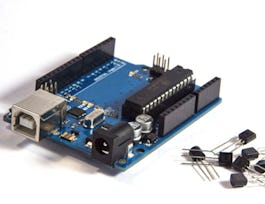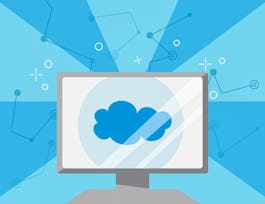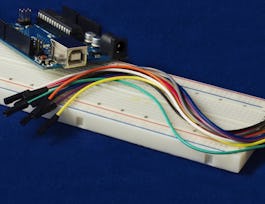Unlock the world of electronics and microcontrollers with this beginner-friendly Arduino course. The course starts by guiding you through the setup of the Arduino IDE and teaching you how to simulate projects in Tinkercad. You'll gradually move from basic circuit design, such as blinking an LED, to more advanced projects involving sensors, displays, and remote controllers. Each section is packed with clear instructions and hands-on activities to ensure you get practical experience.



Arduino For Beginners - 2023 Complete Course

Instructor: Packt - Course Instructors
Sponsored by PTT Global Chemical
Recommended experience
What you'll learn
Identify and recall the fundamental components of an Arduino circuit, such as LEDs, resistors, and sensors.
Explain how digital and analog pins work within an Arduino setup.
Construct basic circuits and program Arduino to perform tasks such as blinking LEDs and reading sensor data.
Debug Arduino projects using tools like the Serial Monitor to diagnose and fix issues.
Skills you'll gain
- Programming Principles
- Computer Science
- C (Programming Language)
- C and C++
- Debugging
- Electrical and Computer Engineering
- Software Development Tools
- Computer Systems
- Embedded Systems
- Electronic Hardware
- Software Engineering
- System Programming
- Computer Programming
- Basic Electrical Systems
- Electronic Systems
- Integrated Development Environments
- Electronic Components
Details to know

Add to your LinkedIn profile
8 assignments
October 2024
See how employees at top companies are mastering in-demand skills


Earn a career certificate
Add this credential to your LinkedIn profile, resume, or CV
Share it on social media and in your performance review

There are 20 modules in this course
In this module, we will introduce you to the Arduino platform and explain its significance in electronics and programming. You will learn about the key materials needed to follow along, along with recommendations for getting started. Additionally, you'll explore how to make the most of online simulation tools and tips for optimizing your learning experience throughout the course.
What's included
5 videos1 reading
In this module, we will walk you through installing the Arduino IDE on your computer and customizing it for an optimal experience. You'll also learn how to connect your Arduino board and ensure it is properly recognized by the software. Finally, we'll introduce you to Tinkercad, a powerful online tool for simulating Arduino projects, and guide you through creating your account and starting your first simulation.
What's included
5 videos
In this module, we will guide you through creating your first Arduino project by making an LED blink. You'll learn about the key functions that control Arduino programs and how to debug issues using the Serial Monitor. Additionally, you will explore different methods to restart your program, both in hardware and software. Through hands-on activities, you'll adjust the blink rate of the LED and print messages when it turns on or off, reinforcing your understanding of debugging and code modification.
What's included
8 videos1 assignment
In this module, we will dive into the fundamentals of building physical circuits for your Arduino projects. You’ll gain a solid understanding of how breadboards work and learn to read resistor color codes accurately. We’ll provide tips for safely manipulating hardware components, then guide you through creating a simple circuit using an LED and a resistor, followed by programming the LED to blink.
What's included
6 videos
In this module, we will explore the foundational programming concepts necessary for Arduino development. You'll learn how to declare and use variables, understand different data types, and structure your code with functions. We’ll also cover conditions and loops, allowing your Arduino to make decisions and perform repetitive tasks. Lastly, you’ll work with arrays to manage collections of data, rounding off with a recap to reinforce these essential coding skills.
What's included
9 videos
In this module, we will focus on using Arduino’s digital pins to control LEDs. You'll learn how digital pins work, both with binary output (on/off) and analog output using Pulse Width Modulation (PWM) to set varying levels of brightness. By the end of the module, you’ll apply these concepts to create a fading effect for an LED, giving you practical experience in using digital pins and PWM in your projects.
What's included
7 videos1 assignment
In this module, we will explore how to use digital pins as input pins by adding a push button to your Arduino circuit. You’ll learn how to detect button presses by reading digital signals and use that input to control an LED. Through a hands-on activity, you’ll create a circuit where the LED lights up only when the button is pressed. Additionally, we’ll introduce the Serial Plotter, a useful tool for visualizing input data directly in the Arduino IDE.
What's included
7 videos
In this module, we will focus on using analog pins with a potentiometer, a device that provides variable resistance. You’ll learn how to read analog values from the potentiometer and use them to control an LED’s brightness. By the end of the module, you’ll complete a practical activity where the LED’s brightness adjusts based on the potentiometer’s position, and we’ll also introduce an extra tip on using analog pins as digital pins for added flexibility in your projects.
What's included
7 videos
In this module, we will recap the different uses of Arduino pins before moving into more advanced hands-on projects. You’ll start by adding two more LEDs to your circuit and building a small traffic light system. Through various activities, you’ll program multiple LEDs to blink based on button input and improve your code by utilizing functions and arrays, making your projects more efficient and organized.
What's included
8 videos1 assignment
In this module, we will explore the fundamentals of serial communication, allowing your Arduino to send and receive data with your computer. You’ll learn how to transmit and receive data using the Serial Monitor and adjust the baud rate to improve communication speed. The module concludes with a practical activity where you'll control the blink rate of an LED by sending data from the Serial Monitor, giving you hands-on experience with real-time data transmission and control.
What's included
6 videos
In this module, we will delve into time management functions to improve the efficiency of your Arduino programs. You’ll learn how to pause execution with delay() and understand the drawbacks of using it. By using alternatives like millis() and micros(), you’ll avoid blocking code execution, enabling multitasking. Through hands-on activities, you’ll rewrite previous programs without using delay() and create projects that run multiple tasks, such as blinking multiple LEDs or executing different actions at the same time.
What's included
11 videos
In this module, we will explore the bounce issue commonly encountered with push buttons, where multiple unintended signals are sent during a single press. You’ll experiment with this problem to see its effects firsthand and then learn the theory behind it. By applying a debouncing technique, you’ll ensure accurate signal reading from the button. The module wraps up with an activity where you’ll use a debounced button press to toggle a different LED, improving the reliability of your button-controlled projects.
What's included
6 videos1 assignment
In this module, we will explore interrupts, a powerful feature that allows your Arduino to respond instantly to external events. You’ll learn when and why to use interrupts and how to set them up in your program. We will also discuss software debouncing within interrupts to handle button inputs reliably. By the end of the module, you’ll complete an activity where you use interrupts to count how many times a button is pressed, ensuring precise and efficient input detection.
What's included
7 videos
In this module, we will introduce the EEPROM (Electrically Erasable Programmable Read-Only Memory), a feature that allows you to store data on your Arduino, even after it’s powered off. You’ll learn when and how to use EEPROM to save and retrieve values for your projects. Through a hands-on activity, you’ll save the maximum brightness of an LED, ensuring that the value persists across program runs and providing a valuable technique for maintaining settings in long-term projects.
What's included
5 videos
In this module, we will explore how to use an ultrasonic sensor to measure distances in your Arduino projects. You’ll learn how the sensor works, using the pulseIn() function to calculate the time it takes for sound pulses to return after hitting an obstacle. We'll also demonstrate how to improve sensor responsiveness by using interrupts. Through practical activities, you'll create a project where different LEDs are powered on based on the detected distance, and we’ll provide extra tips to stabilize sensor readings for more reliable measurements.
What's included
10 videos1 assignment
In this module, we will teach you how to integrate an LCD screen into your Arduino circuit to display text and data in real-time. You’ll learn how to print text on the screen and adjust its contrast with a potentiometer. By experimenting with the cursor position, you can enhance how information is presented. Through activities, you'll display user input from the Serial Monitor and real-time distance measurements from an ultrasonic sensor directly on the LCD screen, making your projects more interactive and informative.
What's included
8 videos
In this module, we will guide you through adding an IR remote control to your Arduino projects for enhanced interactivity. You’ll learn how to install and use different versions of the IR library to receive and map data from the remote. We’ll demonstrate how to create a switch-case structure to respond to various button commands, allowing you to control different components like LEDs. Through a hands-on activity, you’ll program the remote to choose which LED to power on, making your projects more dynamic and user-friendly.
What's included
10 videos1 assignment
In this module, we will explore how to use a photoresistor to detect changes in ambient light. You’ll learn how to connect the photoresistor to your Arduino circuit and read real-time luminosity data. Through hands-on activities, you’ll program the LEDs to automatically turn on when it gets too dark and compute the average light level over a period of time, making your projects more responsive to environmental conditions.
What's included
7 videos
In this final module, we will guide you through building an interactive obstacle detection system, combining all the skills you've developed. You’ll use an ultrasonic sensor to measure distances, adjust LED blink rates based on proximity, and lock/unlock the system with a debounced push button and IR remote controller. The LCD screen will display real-time data, including distance and warning messages, while EEPROM will save user preferences. The project concludes with tips on improving and customizing the system, helping you apply best practices to future Arduino projects.
What's included
15 videos1 assignment
In this final module, we will reflect on everything you’ve learned, from basic Arduino setup and programming to advanced topics like serial communication, interrupts, and sensor integration. You now have the skills to build interactive and complex projects. We’ll also discuss recommendations on what to explore next, whether it’s diving deeper into Arduino libraries, working on personal projects, or experimenting with more advanced sensors and components.
What's included
2 videos1 assignment
Instructor

Offered by
Why people choose Coursera for their career




Recommended if you're interested in Computer Science

University of California, Irvine

University of California, Irvine

University of California, Irvine

Open new doors with Coursera Plus
Unlimited access to 10,000+ world-class courses, hands-on projects, and job-ready certificate programs - all included in your subscription
Advance your career with an online degree
Earn a degree from world-class universities - 100% online
Join over 3,400 global companies that choose Coursera for Business
Upskill your employees to excel in the digital economy



